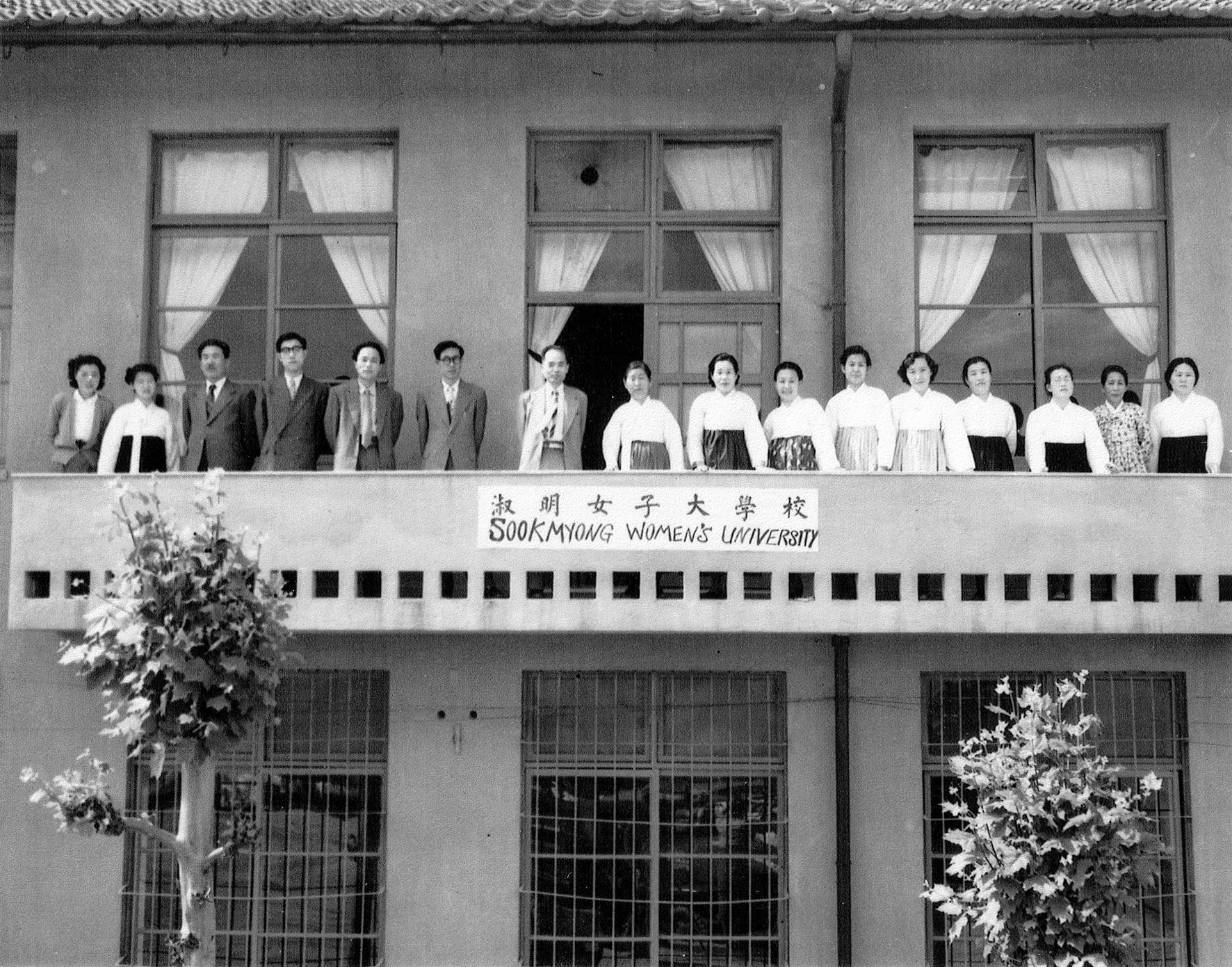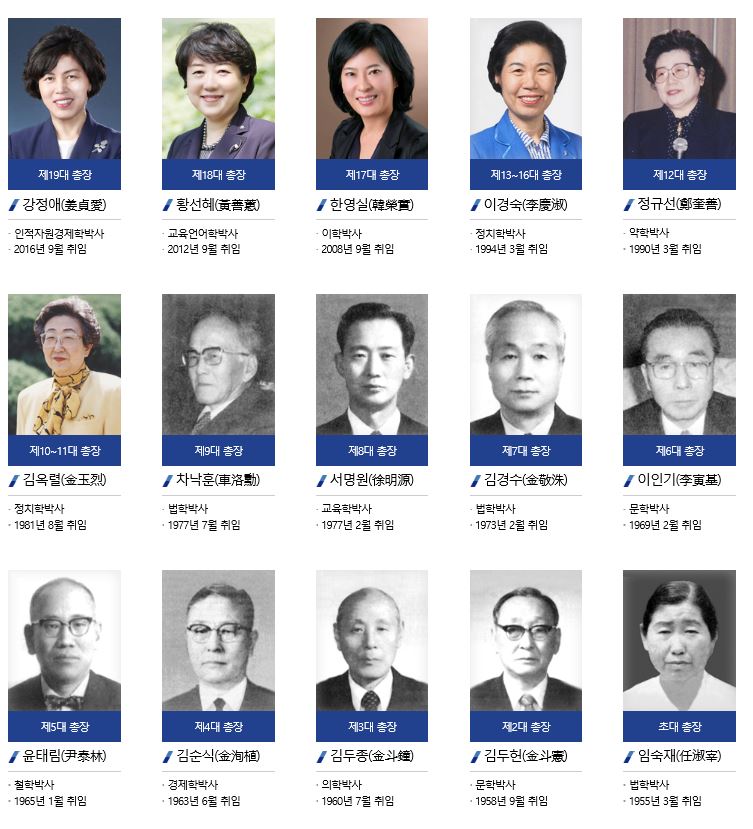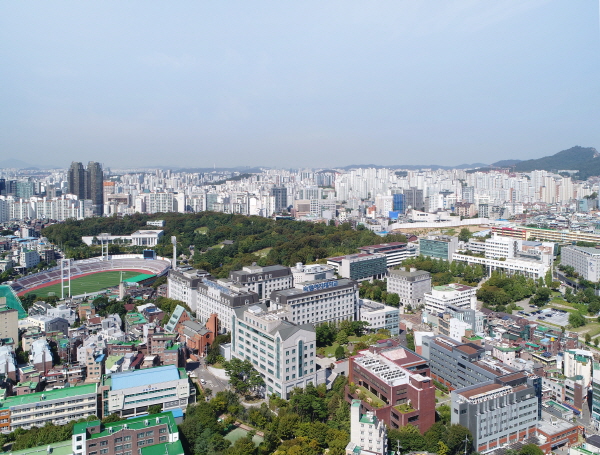[Zoom In] The esteemed history of Sookmyung Women’s University presidents
- Views 11840
- Writer 커뮤니케이션팀
- 보도일자 2020-08-19
|
Let’s shed new light on our presidents who have been in office since 1955, when Sookmyung Women's University was promoted to a university, and also take a closer look at the changes in our election system.
Sookmyung Women's University's first president when the school was promoted to a university was Sookjae Lim, who was a dean at the time. She was appointed as an assistant professor with the opening of Sookmyung Girl's Professional College in 1939 and was put in charge of Joseon sewing department. Since 1945, after the liberation, she was the first Korean principal to be appointed, and has been growing through turbulent times.

<A commemorative photo was taken of President Sookjae Lim and the staff in commemoration of the promotion to a university.>
For about 20 years from 1960 to 1981, after Lim's resignation, outside education officials were appointed as presidents of Sookmyung in the era of military government and the Yushin (Revitalizing Reform) system. Dr. Duheon Kim (doctor of literature), who became the second president of Sookmyung Women’s University in 1958, was a prominent figure in Korea’s educational field. He served as a professor at Seoul National University, chairman of the Jindan Society (Society for Korean History), president of the Korean Federation of Education Associations, and director of the Higher Education Bureau of the Ministry of Education, among others. However, in the wake of the April Revolution, which broke out in the first year of his presidency, he voluntarily resigned. Dr. Dujong Kim, a professor at Severance School of Medicine and a professor at Seoul National University Medical School, was appointed as the third president. Above all, President Kim wanted to promote unity and harmony and boost academic spirit. However, President Dujong Kim also stepped down from his position as president after a year and three months under the military government's temporary special law, which emerged after the May 16 Coup. In 1963, after struggling with various difficulties, Foundation of Sookmyung Women’s School elected Dr. Sun-sik Kim (doctor in economics), Korea's first accountant, as the fourth president.

<View of Sookmyung Women's University campus in the late 1970s>
Through the nation's history of turbulence and turmoil
In the 1960s, as the university was in turmoil due to the ongoing political upheaval, the university faced another challenge due to the participation of the board of directors of the Korean Imperial Family and excessive interference by the Ministry of Education over the operation of the Sookmyung Women’s School Educational Foundation. Since the liberation, Sookmyung Women’s School faced controversies over the composition of the foundation's directors, and since the 1960s, internal conflicts have continued due to financial problems and controversy over the composition of board members, such as the dispatch of a senior director of the Ministry of Education and administrative litigation. In 1965, President Sun-sik Kim also resigned after failing to finish a guaranteed term, and Tae-rim Yun, who served as the deputy minister of education, was inaugurated as the fifth president.
After a period of upheaval, Sookmyung began to clean up its internal turmoil and restore stability in the 1970s. After the termination of President Tae-rim Yun’s office, Dr. In-gi Lee, who was serving as a Dean of Graduate School at Seoul National University, was sworn in as the sixth president, and in 1973, Dr. Gyeongsu Kim, who served as a professor of Korea University’s College of Government and Business and a professor at Sungkyunkwan University’s College of Social Science and Law, was appointed the seventh president. In 1977, Dr. Myong-won Suh, who was the vice president of Seoul National University, was appointed the eighth president, as the control of the Revitalizing Reform increased. However, shortly after the inauguration ceremony, he was transferred to Chungnam National University and resigned in less than 15 days.
Having struggled for almost a semester due to the sudden vacancy of a president, Sookmyung Women’s University began to regain its normality in July 1977 when Dr. Rak-hun Cha became the ninth president. President Cha was an education administrator who served as the Dean of Student Affairs and acting president during his 30 years of service at Korea University.
<The timeline of Sookmyung Women's University presidents_1955~2020>

Election of the first alumni president
When the term of the Ninth President Rak-hun Cha had expired on July 8, 1981, Sookmyung Women’s University agreed to move away from the traditional practice of appointing prominent outside figures as presidents and to appoint competent internal figures. In the interest and expectations of both in and outside the school, the board of directors finally elected Professor Ok-ryol Kim of the Department of Political Science and International Relations as the tenth president on August 14, 1981.
President Ok-ryol Kim, who declared "from Korea’s Sookmyung to Global Sookmyung" as the urgent challenge, succeeded in the unanimous appointment for the second term by the board of directors in 1985, and during her eight-year term, he led the development of our university in various aspects, including expanding the school district, expanding the organization, securing excellent teachers, increasing the number of students, expanding scholarships, and signing sisterhoods.
It is from the twelfth President Kyu-sun Chung that the so-called "conclave" system of electing presidents, which directly selects candidates for president through free voting by professors with the right to vote through a full faculty meeting, has been established. This was due to the fact that the issue of electing a president was highlighted as the biggest issue in the struggle for the democratization of the school during the 1989 school year. President Kyu-sun Chung, who was directly elected by the school members, received her Ph.D. in Pharmacy from Sookmyung Women’s University and gained experience in school administration as a dean and other executive positions of the university. She engaged in various social activities, including a councilor of the Pharmaceutical Society of Korea, a member of the Ministry of Health and Social Affairs’ Central Pharmaceutical Affairs Review Committee, and president of the Korean Society of Mycology.

<100th anniversary commemoration of the school in 2006>
The second establishment of the school and signs of new change
In 1994, Professor Kyung-sook Lee of Department of Political Science and International Relations, became the thirteenth president. President Lee was well-versed in school affairs through serving her alma mater for 20 years and received the full support of her members based on her personality and wisdom. From 1994 until 2008, President Lee held four consecutive terms for the first time in the history of Sookmyung Women's University, recording the longest presidency. In fact, no president was elected four consecutive terms based on direct voting system in the history of universities in Korea.
Yeong-sil Han, professor of Department of Food & Nutrition, was elected as the seventeenth president in 2008. She has been praised as the right person to succeed former President Kyung-sook Lee based on her experience in holding key positions, including the Director of the Korea Food Institute, Dean of Research & Business Development Foundation, Dean of General Affairs, and Dean of Academic Affairs. The highlights of President Han’s tenure include the foundation of the first ROTC in a women's university, and she also focused on expanding educational spaces such as the construction of Sookmyung Business Incubation Center and the establishment of the Sookmyung Heritage Hall. Accordingly, Sookmyung Women’s University achieved 24th place in the QS Asia University Rankings (based on universities with less than 12,000 students without a medical school) and advanced into the top 10 rank in the Joongang Ilbo University Rankings.
In 2012, Hwang Sun-hye, professor of the School of English, was inaugurated as the eighteenth president of Sookmyung Women's University. Soon after her inauguration, President Hwang, who promised to be the "practical" president who listen to the voices of the members, established the College of Engineering with the goal of producing female talents to meet social needs as a hub for global women's education. In addition to employment, she also focused on strengthening entrepreneurial capacity, and achieved success in attracting government and private businesses related to start-ups. In 2016, she also succeeded in winning the Program for Industrial Needs-Matched Education Project (PRIME).

<View of Sookmyung Women's University campus in 2019>
In 2016, when Sookmyung Women's University celebrated its 110th anniversary, there were signs of some change in light of the upcoming presidential election. In the past presidential elections, candidates who received the most votes through a full faculty meeting were selected as the first and second presidential candidates without a separate registration process or policy presentation. However, there has been a steady stream of voices on its shortcomings that "it is difficult for members to fully listen to the candidates' pledges because everything is decided on the election day." Because of this, some candidates had the opportunity to officially announce their candidacy and announce their findings at two pledge presentations. After the vote, Professor Jungai Kang of the Division of Business Administration was elected as the nineteenth president.
In her inaugural address, President Kang declared her ambition to "open an era of renaissance for Sookmyung in which the quality of education, students, and professors is implemented to the highest standards for the cultivation of women leaders who can contribute to the development of the nation, people, and humanity, just as the founding ideology of Sookmyung Women’s University," and proclaimed the vision of "global Sookmyung, opening the future."
Sookmyung Women's University emphasized cooperation with local communities such as Seoul City and Yongsan-gu during the presidency of Kang, and successfully carried out the campus town project, and obtained satisfactory results in the 2nd period evaluation of university’s structural reform and the 1st campus reimbursement cancellation lawsuit. As part of the PRIME project, the Prime Complex, a state-of-the-art lecture hall, was built at the Second Foundation Campus, and she also upgraded the campus infrastructure. Maintaining the No. 1 employment rate of women's colleges amid increasing youth employment difficulties and promoting qualitative growth of technological industry-university cooperation have also been evaluated as her key achievements.




![[Zoom In] 유구한 역사를 지나온 길, 숙명여대 총장사(史)](/_attach/old/dext5editordata/2020/07/20200707_171238204_24687.jpg)